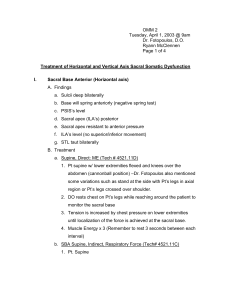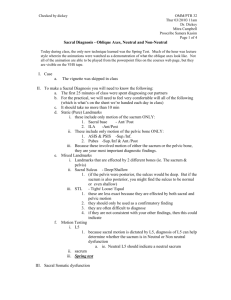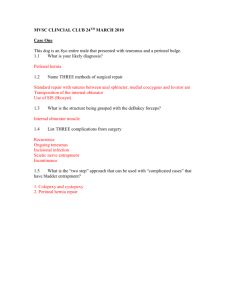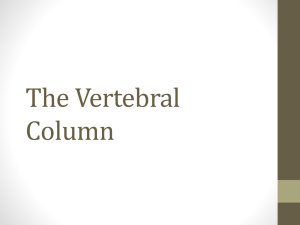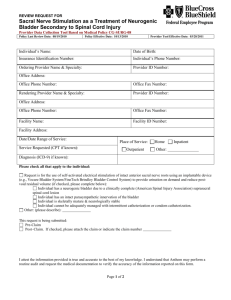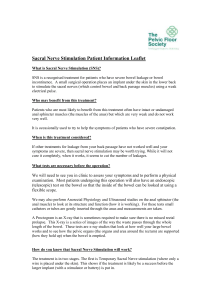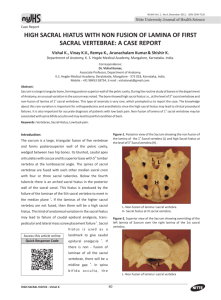ANATOMICAL VARIATIONS OF SACRUM AND ITS CLINICAL
advertisement
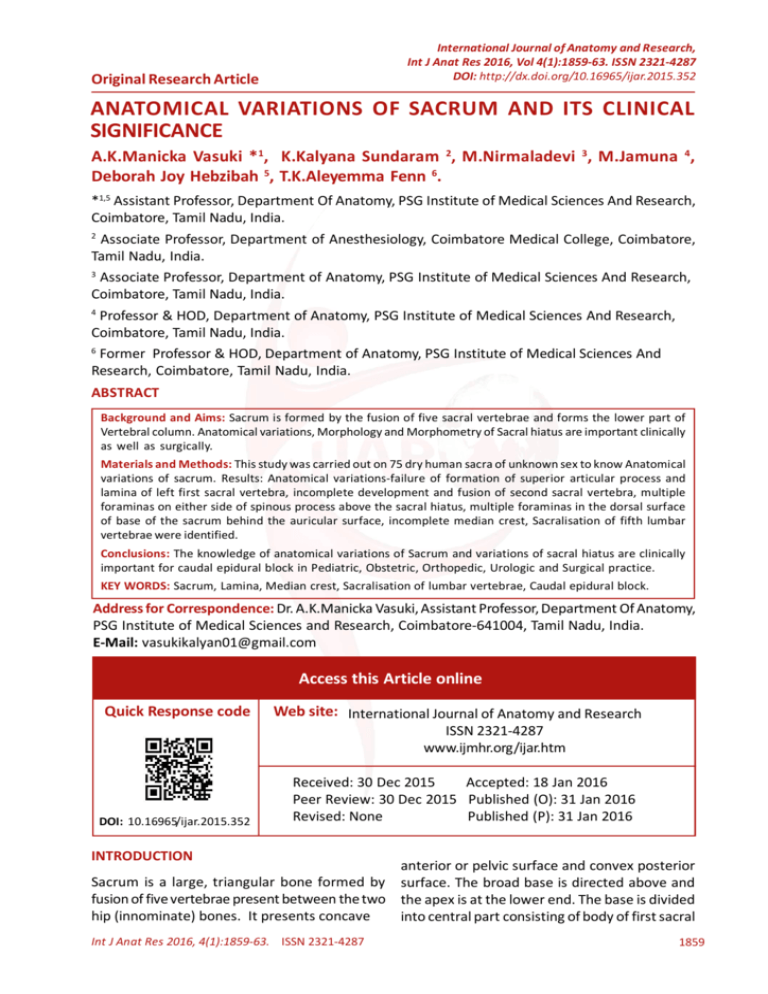
International Journal of Anatomy and Research, Int J Anat Res 2016, Vol 4(1):1859-63. ISSN 2321-4287 DOI: http://dx.doi.org/10.16965/ijar.2015.352 Original Research Article ANATOMICAL VARIATIONS OF SACRUM AND ITS CLINICAL SIGNIFICANCE A.K.Manicka Vasuki *1, K.Kalyana Sundaram 2, M.Nirmaladevi 3, M.Jamuna 4, Deborah Joy Hebzibah 5, T.K.Aleyemma Fenn 6. *1,5 Assistant Professor, Department Of Anatomy, PSG Institute of Medical Sciences And Research, Coimbatore, Tamil Nadu, India. 2 Associate Professor, Department of Anesthesiology, Coimbatore Medical College, Coimbatore, Tamil Nadu, India. 3 Associate Professor, Department of Anatomy, PSG Institute of Medical Sciences And Research, Coimbatore, Tamil Nadu, India. 4 Professor & HOD, Department of Anatomy, PSG Institute of Medical Sciences And Research, Coimbatore, Tamil Nadu, India. 6 Former Professor & HOD, Department of Anatomy, PSG Institute of Medical Sciences And Research, Coimbatore, Tamil Nadu, India. ABSTRACT Background and Aims: Sacrum is formed by the fusion of five sacral vertebrae and forms the lower part of Vertebral column. Anatomical variations, Morphology and Morphometry of Sacral hiatus are important clinically as well as surgically. Materials and Methods: This study was carried out on 75 dry human sacra of unknown sex to know Anatomical variations of sacrum. Results: Anatomical variations-failure of formation of superior articular process and lamina of left first sacral vertebra, incomplete development and fusion of second sacral vertebra, multiple foraminas on either side of spinous process above the sacral hiatus, multiple foraminas in the dorsal surface of base of the sacrum behind the auricular surface, incomplete median crest, Sacralisation of fifth lumbar vertebrae were identified. Conclusions: The knowledge of anatomical variations of Sacrum and variations of sacral hiatus are clinically important for caudal epidural block in Pediatric, Obstetric, Orthopedic, Urologic and Surgical practice. KEY WORDS: Sacrum, Lamina, Median crest, Sacralisation of lumbar vertebrae, Caudal epidural block. Address for Correspondence: Dr. A.K.Manicka Vasuki, Assistant Professor, Department Of Anatomy, PSG Institute of Medical Sciences and Research, Coimbatore-641004, Tamil Nadu, India. E-Mail: vasukikalyan01@gmail.com Access this Article online Quick Response code Web site: International Journal of Anatomy and Research ISSN 2321-4287 www.ijmhr.org/ijar.htm DOI: 10.16965/ijar.2015.352 Received: 30 Dec 2015 Accepted: 18 Jan 2016 Peer Review: 30 Dec 2015 Published (O): 31 Jan 2016 Revised: None Published (P): 31 Jan 2016 INTRODUCTION anterior or pelvic surface and convex posterior Sacrum is a large, triangular bone formed by surface. The broad base is directed above and fusion of five vertebrae present between the two the apex is at the lower end. The base is divided hip (innominate) bones. It presents concave into central part consisting of body of first sacral Int J Anat Res 2016, 4(1):1859-63. ISSN 2321-4287 1859 A.K.Manicka Vasuki et al.ANATOMICAL VARIATIONS OF SACRUM AND ITS CLINICAL SIGNIFICANCE. vertebra and lateral mass or ala on either side. By its base the sacrum articulates with the fifth lumbar vertebra and by its apex it articulates with the coccyx. The base presents the upper opening of sacral canal. The superolateral margin of the body of first sacral vertebra projects forwards as the sacral promontory, which is useful in measuring the diameters of the pelvis. The triangular sacral canal is formed by sacral vertebral foramina. The opening present at the caudal end of sacral canal is known as sacral hiatus. The laminae and spinous process of the fifth and /or fourth sacral vertebrae fail to meet in the midline creating a deficiency known as the hiatus in the posterior wall of the sacral canal [1]. It is located inferior to the fourth or third fused sacral spines or lower end of median sacral crest. The remnants elongate downwards on both sides of sacral hiatus. These two bony processes are called the sacral cornua and define important landmarks during caudal epidural block (CEB). Sacral hiatus is identified by palpation of sacral cornua. Sacral cornua are felt at the upper end of natal cleft 5cm above the tip of coccyx. Structures emerge from sacral hiatus are the filum terminale, fifth sacral nerves and coccygeal nerves. The hiatus provides access to the extradural space in the sacral canal. The anterior surface of Sacrum bears four anterior sacral foramina which give passage to ventral rami of upper four sacral spinal nerves and lateral sacral arteries. The dorsal surface of sacrum bears four posterior sacral foramina which give passage to posterior rami of the upper four sacral spinal nerves. The upper surface of the lateral mass of Sacrum is termed the Ala of Sacrum. Sacral canal contains the cauda equina, duramater and arachnoid mater. At the lower margin of second sacral vertebrae, the subarachnoid space terminate. The fifth sacral roots, coccygeal roots and filum terminale pierce the blind end of the dural tube. Beyond the dural tube, there is roomy extradural space in the sacral canal. Reliability and success of Caudal epidural block depends on anatomical variations of sacral Int J Anat Res 2016, 4(1):1859-63. ISSN 2321-4287 hiatus as observed by many authors.Caudal epidural block has been widely used for treatment of chronic back pain.Sacral hiatus functions as a landmark when caudal anaesthesia is administered in Urology, Proctology,General surgery and Obsterics and Gynaecology practice. The present study was undertaken to find out the variations of Sacrum. MATERIALS AND METHODS The materials for the present study consists of Seventy five dry adult Sacra of unknown sex obtained from Anatomy department, PSG IMS & R, Coimbatore. If there is any anatomical variation of Sacrum, that was identified and noted in each sacrum. The Variations of Sacrum was compared with the Authors. OBSERVATIONS 1. Failure of formation of right first sacral lamina and superior articular process with abnormal bony growth near the first dorsal foramina (Fig. 1). 2. Non-fusion of first sacral lamina (seen in four sacral vertebra) (Fig. 2 to Fig 5). 3. Incomplete development and nonfusion of laminae of second sacral vertebrae (seen in six sacral vertebra) (Fig. 6 to Fig. 11). 4. Absence of median crest with nonfusion of laminas of first and second sacral vertebrae (Fig. 12). 5. Incomplete median crest (Fig. 13). 6. A foramina in the right side of lamina of second sacral vertebrae which indicates incomplete development of right side of second sacral vertebrae (seen in two sacral vertebra) (Fig. 14 and 15. 7. Foraminas on either side below the first spinous process and at the level of second and third spinous process with absence of median crest (Fig. 16 and 17). 8. Foramen just above the apex of sacral hiatus on either side (Fig. 18 and 19. 9. Multiple foraminas in the dorsal surface of base of sacrum behind the auricular surface in the ala for the attachment of Introsseous ligament and dorsal sacroiliac ligament (Fig. 20). 1860 A.K.Manicka Vasuki et al.ANATOMICAL VARIATIONS OF SACRUM AND ITS CLINICAL SIGNIFICANCE. Fig. 1 Fig. 2 Fig. 3 Fig. 4 Fig. 5 Fig. 6 Fig. 7 Fig. 8 Fig. 9 Fig. 10 Fig. 11 Fig. 12 Fig. 13 Fig. 14 Fig. 15 Fig. 16 Fig. 17 Fig. 18 Fig. 19 Fig. 20 Int J Anat Res 2016, 4(1):1859-63. ISSN 2321-4287 1861 A.K.Manicka Vasuki et al.ANATOMICAL VARIATIONS OF SACRUM AND ITS CLINICAL SIGNIFICANCE. Fig. 21 Fig. 25 Fig. 22 Fig. 26 10. Complete dorsal wall agenesis (Fig. 21). 11. Sacralisation of fifth lumbar vertebrae (seen in four sacral vertebra) (Fig. 22 to Fig. 25). 12. High sacral hiatus (Fig. 26). DISCUSSION Complete non fusion of first sacral lamina was observed by Sushanth et al study [2]. Failure of formation of right first sacral lamina and superior articular process with abnormal bony growth near the first dorsal foramina was observed in our study. High sacral hiatus with nonfusion of lamina of first sacral vertebrae was observed by Vishal.K et al [3]. This was also observed in our study. Incomplete development of second sacral lamina was found in Renu Chauhan et al study [4]. We found the same in six sacral vertebrae. Rare osseous growth on the Sacrum was found on the ventral aspect of left side of first sacral vertebral body and the promontory by Puja Chauhan et al5. But in our study, We observed abnormal bony mass near the right side of first sacral foramina with failure of formation of first and second sacral lamina with superior articular process. Complete dorsal wall agenesis of Sacrum was observed by Vanitha et al [6]. In our study, we observed complete dorsal wall agenesis in one sacral vertebra. Int J Anat Res 2016, 4(1):1859-63. ISSN 2321-4287 Fig. 23 Fig. 24 Sacralisation of fifth lumbar vertebra was observed by Kubavat Dharati et al [7]. This was also observed in our study in four sacral vertebrae. The development of Sacrum resembles the ossification of a typical vertebrae [8]. The Sacrum develops from fusion of five vertebrae. After puberty, the sacral vertebrae start fusing with each other. The primary centres which form each half of vertebral arch fuse posteriorly to form complete sacral canal. Complete fusion of five vertebrae as single piece of bone was observed after puberty. Any defect in formation leads to incomplete formation of Sacral canal and incomplete ossification of lamina.Spina bifida occulta or cystic can be accompanied and Neurological defects can be present in such cases. The median crest is formed primarily from the spinous process of the upper three to four sacral vertebrae. The lamina of fifth sacral and sometimes fourth sacral vertebrae does not fuse in the midline. As a result, the opening is termed sacral hiatus. If the laminae of the higher sacral vertebrae are not fused, then there will be a high sacral hiatus. This kind of anatomical variation in the sacral hiatus may lead to failure of caudal epidural analgesia, transpedicular and lateral mass screw placement failure. Lamina on the either side of median sacral crest forms sacral grooves. Number of muscle attachments-Multifidus, Sacrospinalis and Erector spinae muscles originates from these grooves. If the second sacral lamina was not fused, the muscles would fail to get proper attachment on the dorsal aspect of sacrum. The deficiency in the bony posterior wall of sacral canal at the second sacral vertebrae level may predispose the meninges protrusion which results in Spina bifida occulta. 1862 A.K.Manicka Vasuki et al.ANATOMICAL VARIATIONS OF SACRUM AND ITS CLINICAL SIGNIFICANCE. Agenesis of dorsal wall is due to failure of fusion of sacral lamina. Maternal Diabetes during pregnancy has been observed to cause sacral agenesis. The bony growth near the first dorsal foramina may be explained that instead of a single primary ossification centre for the body, separate ventral and dorsal primary ossification centres appear for the centrum which later fuse into single. Based on this, the growth is a developmental anomaly because of the overgrowth of only the dorsal ossification centre overgrowth and incomplete fusion of this centre with first sacral body could be an alternate explanation for the growth. In Sacralisation of fifth lumbar vertebrae, the transverse process of last lumbar vertebrae becomes larger than normal on one side or both the sides and fuses to the sacrum or ilium or both. This is observed in 3.6 to 18% of people and is usually bilateral. In Sacralisation usually L5-S1 intervertebral disc becomes thin and narrow, this abnormality is found by X-Ray. The occurrence of Lumbosacral transitional vertebra (LSTV)-Lumborisation or Sacralisation of fifth lumbar vertebra is linked to its embryological development and osteological defects. Embryologically, the vertebrae receive contribution from caudal half of one sclerotome and from the cranial half of succeeding sclerotome. Because of reduction of length of vertebral column, the incidence of Sacralisation is higher than Lumborisation. Due to Sacralisation of fifth lumbar vertebra, the fusion of Lumbosacral joint might cause great difficulty during labour because of less mobile pelvis and may be the cause for low back pain. It is the one of the cause for lumbar disc prolapse. CONCLUSION Clinicians need to be aware of such conditions and their frequencies because the success of caudal epidural anaesthesia and analgesia depends on the anatomical variations of Sacrum and the hiatus. Neurological symptoms may be caused due to such anomalies. The variations of sacrum need to be known to the Anaesthetists, Radiologists, Surgeons, Orthopedicians and Gynaecologists. Int J Anat Res 2016, 4(1):1859-63. ISSN 2321-4287 Knowledge of this type of variation may be helpful to the Radiologists in interpreting the radiographs of Sacral spine.This variation may also benefit Orthopedicians in diagnosing the cause of Low backpain. It is useful in diagnosing the cause of neurological involvement of bladder, rectum and lower limbs. In the present study, many variations of Sacrum like incomplete formation of first Sacral lamina and superior articular process with bony growth near the first dorsal foramina, nonfusion of first sacral lamina with bony growth near the first dorsal foramina, nonfusion of second sacral lamina, absence of median crest with nonfusion of lamina of first and second sacral lamina, complete dorsal wall agenesis, Sacralisation of fifth lumbar vertebrae, elongated hiatus and narrowing of Sacral canal at the apex of the hiatus were found in higher percentage. These variations should be kept in mind while giving caudal anaesthesia. Conflicts of Interests: None REFERENCES [1]. Standring S. The Back. In: Gray’s Anatomy’s Sacrum.40th ed.Edinburg,UK: Churchill Livingstone 2008:724. [2]. Sushanth, Shishirkumar, Complete nonfusion of sacral lamina-A case study. I.J.S.R 2014;3(7):73738. [3]. V ishal K, Vinay K.V, High sacral hiatus with Nonfusion of lamina of first sacral vertebrae: A case report, Nitte university, J.Health Sci. Dec 2012;2(4):60-62. [4]. Renu chauhan, Jugesh Khanna, incomplete development of second sacral lamina: a case report, I.J.Research in Med.Sci,2013;1(3):278-80. [5]. Puja Chauhan, Sumita Kalra, Arare osseous growth on sacrum, I.J.A.V,2010;3:218-19. [6]. Vanitha, Taqdees Fatima, H.S.Kadlimatti, Complete dorsal wall agesis of sacrum: A case report, I.J.Dental &Medical Sciences 2014;13(4);80-81. [7]. Kubavat Dharati, Nagar et al. A study of Sacralisation of fifth lumbar vertebra in Gujarat, N.J.Medical Research 2012;2(2):211-13. [8]. A.K.Datta, Essentials of Human Embryology, 6th ed.2010;97,278-79. How to cite this article: A.K.Manicka Vasuki, K.Kalyana Sundaram, M.Nirmaladevi, M.Jamuna, Deborah Joy Hebzibah, T.K.Aleyemma Fenn. ANATOMICAL VARIATIONS OF SACRUM AND ITS CLINICAL SIGNIFICANCE. Int J Anat Res 2016; 4(1):1859-1863. DOI: 10.16965/ijar.2015.352 1863
